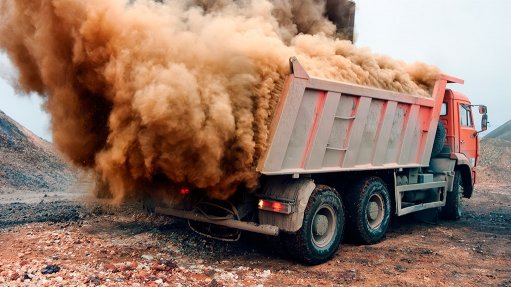
KICKING UP DUST Particulate matter is emitted into the air because of excavations, blasting works, the transportation of materials, wind erosion, fugitive dust from tailings facilities, material stockpiles and waste dumps
The minimum emission standards (MES), arising from Section 21 of the National Environmental Management Air Quality Act 39 of 2004, came into effect in April this year and will have far-reaching implications for the mining industry, says private-sector-owned Richards Bay Coal Terminal health, safety and environmental compliance GM Zanele Mthiyane.
The Act aims to protect the environment and reinforce Section 24(b) of the Constitution, which states that everyone has the right to an environment that is not harmful to their health or wellbeing.
Mthiyane says the MES are applicable to permanently operated mines and experimental (pilot project) mines, or projects that are in the exploratory stage.
“Airborne emissions occur during each stage of the mining cycle, including during exploration, development, operational, waste disposal and beneficiation, as well as during the mine closure and rehabilitation phases,” Mthiyane states.
Particulate matter is emitted into the air because of excavations, blasting works, the transportation of materials, wind erosion (particularly in opencast mines), fugitive dust from tailings facilities, material stockpiles and waste dumps.
Additionally, exhaust emissions from cars, trucks and heavy equipment add to particulate-matter levels. Gas emissions also negatively impact on air-quality levels and they are the result of fuel combustion in stationary and mobile machines, explosions and mineral processing.
Air pollutants released as a result of mining activities can result in significant negative health impact on people and can also negatively impact on the surrounding agricultural viability.
Mining companies and service providers, particularly materials handling and logistics companies, are expected to monitor ambient air quality throughout the life cycle of a commodity.
Mthiyane says trained sampling and monitoring personnel are crucial to ensure the effective monitoring of the MES levels at mines, and at materials collection and dispatch centres.
It is also important that companies’ local community social initiatives educate communities about the potential threats and health implications of air pollution, “. . . as communal awareness about the challenge can greatly assist companies in working with locals to combat air pollution”.
From an operational perspective, she notes that companies must ensure that they implement effective dust-suppression systems at their sites.
Engineering control measures should also be implemented to prevent dust pollution.
“The Act has ensured that air-quality monitoring has become a top priority for all companies operating in the mining sector. Companies’ heightened accountability will ensure improved health and safety levels for mineworkers, local communities and society in general,” Mthiyane concludes.